BREEDING
(Cactus Magazine "Welwitschia" )
At first, growing albino cacti is at first much harder than growing normal ones. They need to be grafted an green stock as soon as possible, They are very small; about one millimetre (Photo 1).
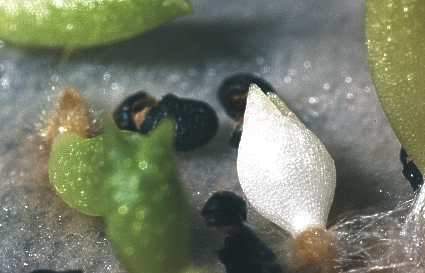 After years of trying different methods, it seems we are on the right track at last. Our percent of successful grafting has been rather high. It demands good skill and timing, with robust, healthy stock. All tools must be absolutely sterile. (We use surgical disinfectants) (Photo 2).
After years of trying different methods, it seems we are on the right track at last. Our percent of successful grafting has been rather high. It demands good skill and timing, with robust, healthy stock. All tools must be absolutely sterile. (We use surgical disinfectants) (Photo 2).
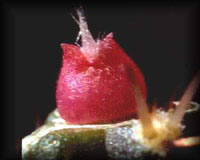 The plants need special care in the first few weeks after grafting, (no direct sun, temperature around 25 ° C, high humidity). As the plants mature, propagation is somewhat easier, as with other green plants, except that water should never be sprayed on directly on the plant. Liquid fertiliser and pesticides that touch the plant's epidermis may cause ugly burns. To protect the plants against mites, we suggest using a vacuum cleaner! (Photo 3).
The plants need special care in the first few weeks after grafting, (no direct sun, temperature around 25 ° C, high humidity). As the plants mature, propagation is somewhat easier, as with other green plants, except that water should never be sprayed on directly on the plant. Liquid fertiliser and pesticides that touch the plant's epidermis may cause ugly burns. To protect the plants against mites, we suggest using a vacuum cleaner! (Photo 3).
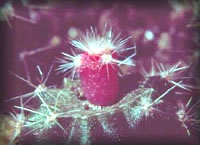 Propagation by offsets is harder as it seems. Offsets don't grow from identical cells. Plants from the same clone don't have the same colour and habit in the second generation. The plants become smaller, less coloured, and have smaller and thinner spines. They are more sensitive, with their epidermis not beeing as successful at protecting them against fungi, and necrosis often appears in late autumn.
Propagation by offsets is harder as it seems. Offsets don't grow from identical cells. Plants from the same clone don't have the same colour and habit in the second generation. The plants become smaller, less coloured, and have smaller and thinner spines. They are more sensitive, with their epidermis not beeing as successful at protecting them against fungi, and necrosis often appears in late autumn.
 Proportion between the chloroplasts and other pigments in the cells define the colour of the plant. Power and wavelengths of the light are also important. We get the best results in using greenhouses covered with plastic (polycarbonate), and find that plants under glass become more greenish and elongated.
Proportion between the chloroplasts and other pigments in the cells define the colour of the plant. Power and wavelengths of the light are also important. We get the best results in using greenhouses covered with plastic (polycarbonate), and find that plants under glass become more greenish and elongated.
Off-sets from albino plants sometimes revert to a normal green colour. The explanation for this phenomenon could be as follows: (Picture 4).
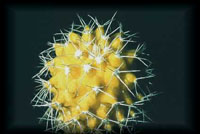 Picture 4: The cells possess a few functional chloroplasts, but not enough to show the colour. Mitosis can separate the cell coincidentally in the A -B direction or the C - D direction. If the direction is A -B, both daughter cells are not green and tissue that arises from them is the same colour as before. In the C - D direction, one of the new cells has enough chloroplasts, and tissue from that cell can be more or less green. The opposite seems to happen when a yellow or red offsets arises from a normal green plant. (after Muntzing 1967)
Picture 4: The cells possess a few functional chloroplasts, but not enough to show the colour. Mitosis can separate the cell coincidentally in the A -B direction or the C - D direction. If the direction is A -B, both daughter cells are not green and tissue that arises from them is the same colour as before. In the C - D direction, one of the new cells has enough chloroplasts, and tissue from that cell can be more or less green. The opposite seems to happen when a yellow or red offsets arises from a normal green plant. (after Muntzing 1967)
 This hypothesis is too simple and experiments show other possibilities. Other substances, perhaps hormones, which arise from stock, may influence the recovery of the chloroplasts. Very strong stocks (Harisia jusbertii, ~50 cm high) cause the normalisation of some, but not all, albinos. The change is permanent, even if the plant is regrafted onto a smaller stock.
This hypothesis is too simple and experiments show other possibilities. Other substances, perhaps hormones, which arise from stock, may influence the recovery of the chloroplasts. Very strong stocks (Harisia jusbertii, ~50 cm high) cause the normalisation of some, but not all, albinos. The change is permanent, even if the plant is regrafted onto a smaller stock.
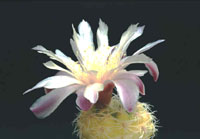 The coloration of the tissue changes in many specimens Sometimes the younger parts of the cactus are greener, while the older parts become yellow or red and opposite.
The coloration of the tissue changes in many specimens Sometimes the younger parts of the cactus are greener, while the older parts become yellow or red and opposite.
Many people think that old albino cacti are not very beautiful, because the older tissue becomes corky and colourless. In this context, 2 - 3 years old plants sre the most beautiful.
 Photo 5. Mammillaria tolimensis 'Aurea' originates in Austria, it was produced by W. Reppenhagen. It has a color of ripe corn. It didn't bloom yet and doesn't produce off-sets. Photo: jure.slatner@guest.arnes.si
Photo 5. Mammillaria tolimensis 'Aurea' originates in Austria, it was produced by W. Reppenhagen. It has a color of ripe corn. It didn't bloom yet and doesn't produce off-sets. Photo: jure.slatner@guest.arnes.si
Photo 6. Among mixed seeds one albino plant of an unknown Mammillaria appeared. At first it seemed without its future. But when it shows its contrast red flowers on the golden body it really is a pleasant looking plant. Photo: jure.slatner@guest.arnes.si
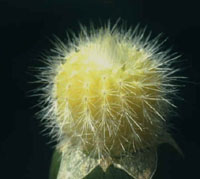 Photo 7. Gymnocalycium bruchii cv. lutea still has some chlorophyll in the younger tissue. Photo: matija.strlic@uni-lj.si
Photo 7. Gymnocalycium bruchii cv. lutea still has some chlorophyll in the younger tissue. Photo: matija.strlic@uni-lj.si
Photo 8. A young plant of Turbinicarpus cv. Aurea showing juvenile colouration. Photo: jure.slatner@guest.arnes.si
Photo 9 Notocacus cv. Aurea is a hybrid between N. leninghausii in N. magnificus. It grows very slowly, after seven years it is 5 cm high. Photo: jure.slatner@guest.arnes.si





